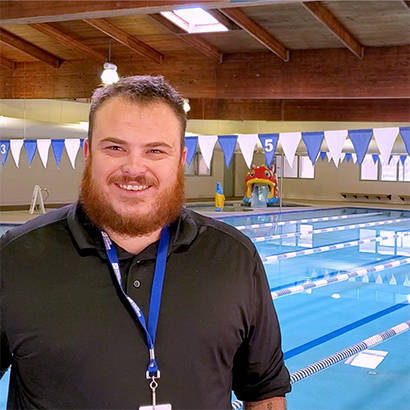
The Goodson Recreation Center transformed its "pool" air quality
If you can’t see your facility’s pool, you shouldn’t be able to smell it. The chemical “pool” smell that invades hallways, lobbies and locker rooms is not only unpleasant, but is also toxic to inhale. So, aquatics facilities, like the South Suburban’s Goodson Recreation Center in Centennial, Colorado, have adopted new technologies to help mitigate poor air quality.
The Challenge
The Goodson Recreation Center’s indoor pools were consuming too much chlorine and, at the same time, swimmers, staff and patrons were all exposed to the “pool” odor that permeated the entire facility.
Aquatics facilities that use a single form of sanitation run the risk of making the pool and the surrounding areas stuffy and odorous. There is a common misconception that chlorine is the source of “pool” odor when, in fact, it is the result of too much expended chlorine in the form of combined chlorine. Combined chlorine forms when the chlorine in pool water mixes with organic and inorganic contaminants in the water, such as sweat, skin oils, urea, etc. Once combined chlorine is formed, it has a limited ability to disinfect pool water. Combined chlorine is 25 times less effective than free chlorine, or the chlorine you purchase. Also, as chloramines (formed when chlorine is combined with a small amount of ammonia), combined chlorine carries toxic volatile organic compounds (VOCs) gas with them. Both elements not only hurt patrons and staff, but also affect the facility.
In addition to causing an unpleasant “pool” odor, exposure to combined chlorine can cause patrons and staff to experience discomfort and develop harmful health issues, such as irritated red eyes and skin, allergies and asthma, and Lifeguard lung, which causes chronic coughing, chest tightness, headaches and shortness of breath.
Some aquatics facilities shock their pools with additional chlorine to mitigate combined chlorine problems. The Goodson Recreation Center sought an easier, more effective and sustainable solution to break this painful cycle.
The Solution
Travis Toler, aquatics coordinator at the Goodson Recreation Center, knew that complementing their primary chlorine disinfection with secondary or supplemental sanitation would help reduce combined chlorine and the “pool” odor it creates. While primary disinfection options, like chlorine or bromine, kill common pathogens, they do not cover the full scope of sanitation.
The facility’s search for secondary sanitation led Toler to Clear Comfort’s Advanced Oxidation Process (AOP) pool treatment. This AOP system uses hydroxyl radicals to do much of the work that traditional chlorine would by oxidizing and eliminating contaminants in the water. These hydroxyl radicals are highly reactive, short-lived and the most powerful oxidative compounds available for recreational water treatment.
Toler, who has been in the aquatics industry for more than 15 years, was skeptical about newer technologies, like Clear Comfort’s AOP. “I thought this was snake oil,” he says. “I wasn’t sure, and I needed some convincing.”
Despite his reservations, in April 2019, he installed the system on their indoor lap pool, hot tub and wading pool and monitored its results.
The Result
After 10 weeks of measuring combined chlorine and chlorine consumption, as well as receiving input from the staff and patrons, Toler was able to see a significant improvement.
“The truth is, I was wrong. It’s excellent,” Toler reports. “I love it, to be honest. It’s much easier to manage.”
With Clear Comfort’s AOP, the Goodson Recreation Center was able to reduce its combined chlorine and chlorine consumption, while maintaining better water clarity.
“I know our chlorine consumption, our bleach usage, has been much lower,” says Toler. “So, overall, it has just improved everything.”
With less combined chlorine, swimmers, patrons, the facility supervisor and other staff members have all noticed an improvement in the facility’s “pool” odor and overall air quality. In recreational aquatics facilities, Clear Comfort’s AOP pool treatment is proven to reduce up to 70 percent of disinfection by-products (DBPs), which is a type of combined chlorine.
“The biggest impact I’ve noticed,” Toler says, “is definitely air quality. We’ve gotten a lot of positive feedback from patrons and from the staff. Even the swimmers: a lot of our swim teams and coaches have commented and said that they notice a difference as well. It’s easier to breathe in here, not so humid, the air quality feels much better and is more ‘pure,’ as one of them said,” he explains.
Moving forward, Clear Comfort’s AOP pool treatment will also help the facility reduce the risk of recreation water illnesses (RWIs), like Cryptosporidium parvum (Crypto). Reducing and eradicating chlorine-resistant microorganisms, like Crypto, are key components to being compliant with the Model Aquatic Health Code (MAHC).
AOP: The End of Pool Smell
The bottom line is that less combined chlorine means less problems for aquatics facilities. Reducing combined chlorine and DBPs is essential for removing “pool” odor and the health problems that accompany it. In addition, facilities benefit from lower wear and tear on heating and air conditioning units, as well as structural elements that corrode from these foul-smelling compounds.
As the recreational water industry progresses, complete water solutions that safely lower the harmful effects of chemicals are becoming the standard for health- and eco-conscious aquatics facilities. Advanced technologies, like Clear Comfort’s AOP, provide a more sustainable way for recreation centers to protect the health of their patrons, local communities and environment.
To learn more about how your facility can reduce combined chlorine, visit Clear Comfort's website.
References
- Disinfection Byproduct Removal
- Measurement of Inactivation of Cryptosporidium Parvum and Bacillus Subtilis Spores Using the Clear Comfort System
- 2018 Model Aquatic Health Code: Code Language
Zach Morris is the Director of Customer Success for Clear Comfort.

